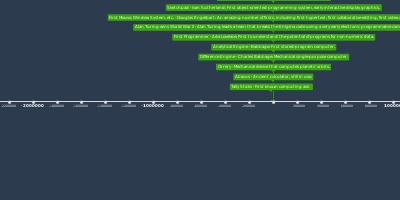jan 1, 2006 - Chess program beats world champion - Deep Fritz program beats Vladimir Kramnik.
Description:
Programmers have been trying to design and build chess programs since at least 1941 (Konrad Zuse). Over the following decade, several of the leading computer science researchers (including Alan Turing, in 1951) published ideas for chess algorithms, but the first actual running programs came in 1957. In 1978, a chess program won a game against a human chess master, David Levy, but Levy won the six-game match 4½–1½. (The half points mean that one game was a tie.)
There are only finitely many possible chess positions, so in principle a program could work through all possible games and produce a complete dictionary of the best possible move for each player from each position. But there are about 1043 board positions, and in 1950, Claude Shannon estimated that there are about 10120 possible games, far beyond the capacity of even the latest, fastest computers. Chess programs, just like human players, can only work out all possible outcomes of the next few moves, and must then make informed guesses about which possible outcome is the best.
A turning point in computer chess came in 1981, when the program Cray Blitz was the first to win a tournament, beat a human chess master, and earn a chess master rating for itself. The following year, the program Belle became the second computer program with a chess master rating. In 1988 two chess programs, HiTech and Deep Thought, beat human chess grandmasters.
In 1997, Deep Blue, an IBM-built special-purpose computer just to play chess, with 30 processors plus 480 special-purpose ICs to evaluate positions, beat world chess champion Garry Kasparov in a six-game match, 3½–2½. Its special hardware allowed Deep Blue to evaluate 200 million board positions per second.
In 2006, world chess champion Vladimir Kramnik was defeated 4-2 in a six-game match by Deep Fritz, a chess program running on an ordinary computer. Although the score looks overwhelming, one of the games Deep Fritz won was almost a win for Kramnik, who failed to see a winning move for himself and instead set up the computer for a one-move checkmate. Without this blunder, the match would have been tied 3–3.
Chess programs continue to improve. In 2009, the program Pocket Fritz 4, running on a cell phone, won a tournament and reached grandmaster rating. The program, in contrast to Deep Blue, could evaluate only 20,000 positions per second, so this win shows an improvement in strategy, not just an improvement in brute force computer speed.
Added to timeline:

History of Computers
Date:
